
Supporting mutual aid efforts and organizations that center Black Americans, joining Black Lives Matter protests, and using the platform or privilege you have to amplify Black folks’ voices are all essential parts of anti-racist action. For many intending allies or accomplices, however, the first step has been learning more about the systems we’re fighting against and the lived experiences of the people we’re fighting for and with.
It is not the job of Black people to teach white people how to be anti-racist, so self-education is a good place to start. Undoubtedly, 2020 was the year of the anti-racist reading list — but that moment also made clear that being aware of systemic issues or the fights for racial justice, equity and liberation isn’t the same as actively contributing to said fights. “An anti-racist reading list means well. […] Still, I am left to wonder: Who is this for?” Lauren Michele Jackson wrote in a 2020 Vulture article. “It is unclear whether each book supplies a portion of the holistic racial puzzle or are intended as revelatory islands in and of themselves.”
That said, there are inherent flaws embedded in any anti-racist reading list. Texas librarian Michelle Marve (@blkMYmorris) echoed this notion in 2020, tweeting, “[T]he list isn’t for one type of reader but offering entry points for different readers… If I could talk to each person individually, I could offer 1 or 2 books but instead [lists] have to cover a lot of different reading levels, preferences, and experiences.” With this in mind, the following list is intended to offer entry points to a variety of readers. Just remember: there’s no finish line here — and education without further action is insufficient.
Support Black-Owned Indie Bookstores: An Additional Way to Support Black Writers and Business Owners
You can find these titles, and other recommended reading, on the website Bookshop, which allows you to select a local bookstore to support when you make a purchase. You can also download an eBook (also via Bookshop) or listen to an audiobook version via a service like libro.fm, your virtual indie audiobook shop.
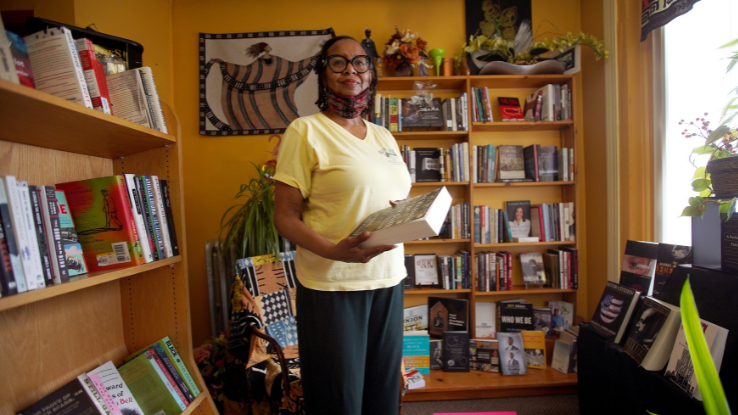
When selecting an indie to support via Bookshop or online, choose a Black-owned store, such as The Lit. Bar (The Bronx, NY), The Key Bookstore (Connecticut), Sistah Scifi (Washington), Café con Libros (Crown Heights, Brooklyn, NY), Marcus Books (Oakland, CA), Eso Won Books (South Los Angeles, CA), Semicolon Bookstore & Gallery (Chicago, IL), Hakim’s Bookstore (Philadelphia, PA), Black Stone Bookstore & Cultural Center (Ypsilanti, MI), Mahogany Books (Washington, D.C.), Harriett’s Bookshop (Philadelphia, PA), Pyramid Books (Boynton Beach, FL) or Source Booksellers (Detroit, MI).
Entry Points for Readers Who Are Just Waking Up
Need a starting point when it comes to interrogating whiteness and understanding anti-racism? These more instructional works will help you build a solid, foundational understanding.
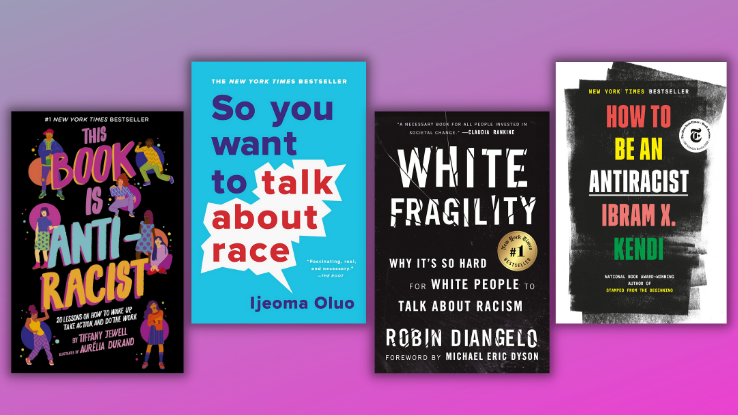
This Book Is Anti-Racist: 20 Lessons on How to Wake Up, Take Action, and Do the Work by Tiffany Jewell with Illustrations by Aurelia Durand
Activist Angela Davis once said, “In a racist society, it’s not enough to be non-racist — we must be ANTI-RACIST.” For white folks who need a primer on what it means to be actively anti-racist, Tiffany Jewell’s book, full of illustrations by Aurélia Durand, is a great place to start. The book’s copy states that it aims to show you “how you can use your anti-racist lens and voice to move the world toward equity and liberation” and does so by first providing readers with the history of racism in America.
With stories about important historical figures — such as the former slave Toussaint Louverture, who led a rebellion against white planters that eventually led to Haiti’s independence — and the accompanying captivating illustrations, this book is both accessible and empowering. If you’re looking for a way to speak to your kids about racism and anti-racism, this book will better equip you with the knowledge and language you need to do so.
So You Want to Talk About Race by Ijeoma Oluo
So You Want to Talk About Race doesn’t shy away from discussing white supremacy, police brutality and the mass incarceration of Black Americans. And it also addresses the everyday, insidious manifestations of racism and, in a sense, acts as a guide to confronting these manifestations (racist jokes, white folks not acknowledging their privilege and so on).
Additionally, Oluo takes (often misunderstood) words and concepts — like intersectionality and affirmative action — and guides readers through these subjects in an honest, conversational way. That’s part of the power of the book: It gives folks the tools, language and confidence to have open conversations about race. If you’re a white person struggling to have frank conversations with your family about race and white supremacy, So You Want to Talk About Race is a great starting point.
White Fragility by Robin Diangelo
If you’re white and have been confronted about the way you uphold — and benefit from — racist institutions and systems, you’ve probably gotten defensive or tried to skirt around the issue of racism. That is, when white people think of racism, they think of examples of explicit bigotry, of narrow-minded people using offensive language or committing acts of hate and violence. And this is why Robin DiAngelo’s White Fragility is such essential reading.
As Claudia Rankine notes, DiAngelo’s work “allows us to understand racism as a practice not restricted to ‘bad people.'” White fragility, which is characterized by a white person’s anger, fear, guilt, defensiveness and, often, silence, prevents folks from having “meaningful cross-racial dialogues.” That is, white fragility — this inability to be held accountable, to feel discomfort and acknowledge white privilege, among other things — protects racial inequality. By calling out the elephant in the room, White Fragility aims to help white folks engage in a more constructive and honest way.
How to Be an Antiracist by Ibram X. Kendi
When Amy Cooper, a white woman, threatened and then called the police on Christian Cooper, a Black man who was birdwatching in New York’s Central Park, she hid behind her white privilege and ingrained racist attitudes. And then she had the gall to claim she isn’t a racist. This is, unfortunately, a very, very familiar story. Moreover, this viral moment reiterates that it’s not enough to say you aren’t racist — or to not do overtly racist things.
In his book How to Be an Antiracist, Ibram X. Kendi, who served as the director of the Antiracist Research and Policy Center at American University before moving to Boston University’s Center for Antiracist Research, writes that “When racist ideas resound, denials that those ideas are racist typically follow.” Kendi goes on to say that “the opposite of ‘racist’ isn’t ‘not racist.’ It is antiracist.” Being antiracist implies taking action; to be silent, to turn away, is a privilege. White people must actively work against racist institutions and systems they benefit from, they must stand up and speak out when they see racism occurring — and Kendi’s book is a great first step on this journey of self-awareness and learning to take action, every day.
Nonfiction, Essays & Art: A More Honest Look at American History
Where we are today stems from how we acted in the past. These works will help you understand the history of how our country treated Black Americans after slavery — and how those in power implemented a new form of slavery through mass incarceration.
And, by reading letters and essays that capture particular time periods in American history, you can gain a better understanding of how Black Americans experience our country — and how little it has changed between the 1960s and today.
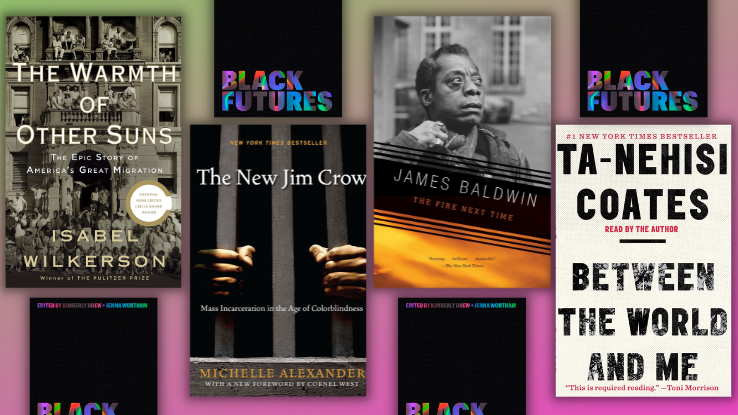
The Warmth of Other Suns by Isabel Wilkerson
The Warmth of Other Suns: The Epic Story of America’s Great Migration by Isabel Wilkerson is, perhaps, the definitive historical study and analysis of the Great Migration. Between 1915 and 1970, roughly 6 million Black Americans left the rural South for urban centers in the Northeast, Midwest and West due to the South’s poor economic conditions and upholding of racist Jim Crow laws.
The migration is split into the Great Migration and the Second Great Migration, the latter of which occurred around World War II and saw Black folks moving West more so than North or to the Midwest. By combining statistics, general history and three biographies, Wilkerson provides a more complete, textured picture of the migration of Black Americans, making it essential reading for anyone who wants a fuller understanding of this often-overlooked exodus that shaped U.S. history.
The New Jim Crow: Mass Incarceration in the Age of Colorblindness by Michelle Alexander
Without a doubt, Michelle Alexander’s seminal work, The New Jim Crow, shifted the popular (white) perception of the U.S. criminal justice system and helped to fuel a movement for social change. In her book, Alexander notes that “we have not ended racial caste in America; we have merely redesigned it.” That is, by targeting Black men through racist policies like the War on Drugs, America’s criminal justice system solidified its function: to decimate communities of color, to become the “new Jim Crow.”
Writing for The New York Times, Ibram X. Kendi, author of How to Be an Antiracist, praised Alexander for “[putting] the entire criminal justice system on trial, [and] exposing racial discrimination from lawmaking to policing to the denial of voting rights to ex-prisoners.” Echoing the notion that The New Jim Crow is a call to action, Kendi added that the book “struck the spark that would eventually light the fire of Black Lives Matter.”
The Fire Next Time by James Baldwin
Considered one of the most influential books about race relations to be published in the 1960s, James Baldwin’s The Fire Next Time collects two of the acclaimed writer’s essays, “My Dungeon Shook — Letter to my Nephew on the One Hundredth Anniversary of the Emancipation” and “Down at the Cross — Letter From a Region of My Mind.” In the first essay, Baldwin writes a letter to his young nephew about how central race is in the shaping of American history and, in the second, the activist explores the relationship between race and religion.
In addition to essays, Baldwin wrote short stories, novels, plays and poetry, all of which examine how race, class, sexuality and masculinity intersect and are most often set against the backdrops of the Civil Rights Movement and the Gay Liberation Movement. If you’re looking to read more of Baldwin’s extensive work but don’t know where to start, we suggest his essays, which were collected in Notes of a Native Son, as well as the novels If Beale Street Could Talk and (the semi-autobiographical) Go Tell It on the Mountain.
Between the World and Me by Ta-Nehisi Coates
In 2015, Ta-Nehisi Coates wrote an article for The Atlantic titled “Letter to My Son,” which was a modernized take on James Baldwin’s “Letter to my Nephew on the One Hundredth Anniversary of the Emancipation.” Much like Baldwin, Coates discussed what it meant (and means) to be Black in America at the time of his writing the article. This eventually evolved into Between the World and Me, a book-length letter written to the author’s son about how it feels to be — and the realities of being — Black in the U.S.
In recounting both his own youth in Baltimore and the whole of American history, Coates describes the “racist violence that has been woven into American culture” — into institutions, like schools and law enforcement. Called “essential, like water or air,” by A.O. Scott in The New York Times, Between the World and Me‘s essentiality is perhaps best described by Toni Morrison, who wrote that it fills “the intellectual void” left by Baldwin’s death.
Black Futures by Jenna Wortham & Curator Kimberly Drew
Filled with a variety of content — tweets, recipes, paintings, essays and more — this anthology of Black art is a must-read. While it does include conversations with academics and activists, Kimberly Drew and Jenna Wortham’s collection of works is itself a work of art — a compendium of Black thinkers and creators that isn’t necessarily meant to be didactic, but thoroughly enjoyed.
The sheer variety of works is part of the beauty — a kind of bound patchwork that sets out to answer the duo’s complicated question: What does it mean to be Black and alive right now? Called a “blueprint for this moment and the next” by The New York Times Book Review, Black Futures is a wholly immersive literary experience, as brilliant as it is stunning.
Black Feminist Theory & Essays: Understanding the Structures & Forces That Shape Us
In general, theory can help us understand the seemingly unnameable forces and structures working against us. As such, the Black feminist writers included below give language to the particular experiences of Black folks.
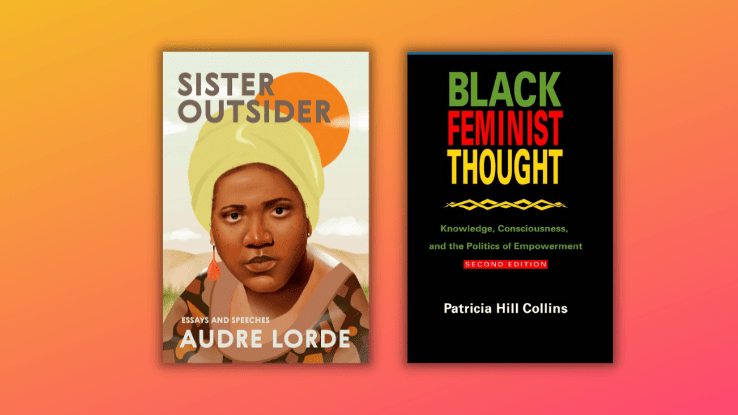
Sister Outsider: Essays and Speeches by Audre Lorde
Sister Outsider: Essays and Speeches is, arguably, activist, thinker and writer Audre Lorde’s most well-known work — and one of the greatest contributions to feminist theory. In it, she writes about her identity as a Black woman — as a lesbian, a poet, an activist, a cancer survivor, a mother and a feminist writer.
The title, which is paradoxical in nature, underscores the multiplicities of Lorde’s identity, which position her “on the line” in a space that isn’t necessarily safe. In addition to examining these intersections of identity, Sister Outsider discusses topics such as imperialism, coalition building, violence against women, police brutality, Black feminism, self-love and more. A critic for The New York Times noted that “[Lorde’s] works will be important to those truly interested in growing up sensitive, intelligent, and aware.”
Black Feminist Thought: Knowledge, Consciousness and the Politics of Empowerment by Patricia Hill Collins
Published in 1990 by Patricia Hill Collins, Black Feminist Thought explores the ideas of Black feminist intellectuals and provides readers with a framework for digging into the works of some of the most prominent Black feminist thinkers of all time, including bell hooks, Audre Lorde, Angela Davis and Alice Walker. From discussions about “controlling images” — negative representations and images that reinforce racist stereotypes — to self-definition, or “the power to name one’s own reality,” Collins puts language to the forces that act upon Black women.
Before writing Black Feminist Thought, Collins coined the term “outsider-within,” which speaks to the ways in which Black women cannot fully be part of mainstream feminist thought, which assumes and centers whiteness, nor Black social thought, which centers maleness. In giving language to the experiences of Black women, and by outlining the often-erased canon of Black feminist art and thought, Collins cements her place as a thinker we all must engage with.
Autobiography & Memoir: Firsthand Accounts from Black Writers
Hear from Black writers who have confronted racism in all its machinations and then chosen to share their lived experiences with readers.
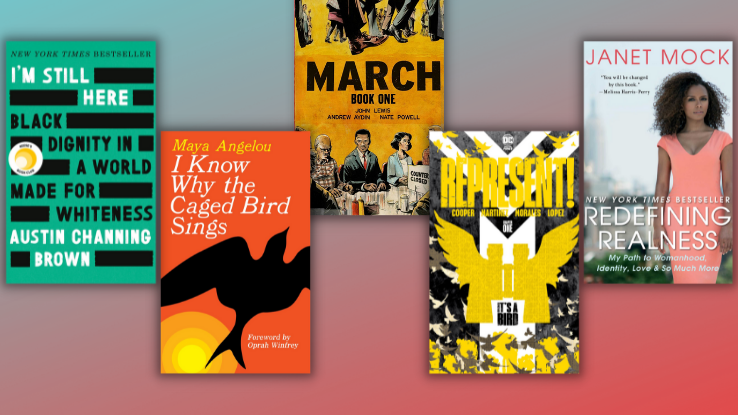
I Know Why the Caged Bird Sings by Maya Angelou
Challenged by her friend, James Baldwin, to write an autobiography that doubled as a work of literature, poet and writer Maya Angelou crafted the coming-of-age story I Know Why the Caged Bird Sings. In the book, a young Maya deals with the pain of abandonment, the prejudice of the white people around her and the trauma of being attacked and raped. As her journey continues, Maya learns about self love and begins to feel empowered by great literature.
“I Know Why the Caged Bird Sings liberates the reader into life simply because Maya Angelou confronts her own life with such a moving wonder, such a luminous dignity,” Baldwin noted. Nominated for the National Book Award in 1970, the book has long been taught in high schools and universities; if your reading list didn’t include Angelou’s seminal work, it’s time to remedy that oversight.
It’s a Bird by Christian Cooper with Art by Alitha Martinez
Many readers will associate Christian Cooper’s name with birdwatching and the creation of Black Birders Week. In May 2020, Amy Cooper, a white woman who was walking her dog, called the cops on Christian Cooper, simply because he was a Black man who asked her to leash her dog, as is required in New York City’s Central Park. But Christian Cooper should be more widely known for being Marvel’s first openly gay writer and editor.
In addition to writing and editing for the X-Men, Alpha Flight and Ghost Rider series, Cooper introduced the first openly gay character to the Star Trek universe, earning him a GLAAD nomination. Although Cooper may not work with Marvel in his day-to-day anymore, he certainly has ties to comics. In 2020, he wrote It’s a Bird for DC Comic’s Represent! series. Based on the Central Park birdwatching incident, the graphic novel tells the story of Jules, a Black teen who’s given an old pair of binoculars — an item that not only shows him more of the world, but helps to keep him safe.
Redefining Realness by Janet Mock
When the Ryan Murphy-produced show Pose premiered on FX in 2018, Janet Mock made history as the first transgender woman of color to write and direct an episode of a TV show. But, several years before that history-making moment, Mock wrote about her experiences as a young transgender girl in her coming-of-age memoir Redefining Realness.
Informed by seminal works like Zora Neale Hurston’s Their Eyes Were Watching God, Mock’s Redefining Realness tells the story of her courageous quest for self. Expressing her admiration for the memoir, acclaimed feminist thinker and activist bell hooks notes that Mock’s work is “told with a spirit of raw honesty that moves beyond confession to redemptive revelation,” and that “this book is a life map for transformation — for changing minds.”
I’m Still Here: Black Dignity in a World Made for Whiteness by Austin Channing Brown
“White people can be exhausting. It’s work to be the only person of color in an organization, bearing the weight of all your white coworkers’ questions about Blackness,” Austin Channing Brown writes in her book I’m Still Here: Black Dignity in a World Made for Whiteness. “…It’s work to do the emotional labor of pointing out problematic racist thinking…. Quite frankly, the work isn’t just tedious. It can be dangerous for Black women to attempt to carve out space for themselves — their perspective, their gifts, their skills, their education, their experiences — in places that haven’t examined the prevailing assumption of white culture.”
When asked by the Chicago Tribune if she wrote I’m Still Here to educate white people or to affirm the experiences of folks in the Black community, Channing Brown said that she had Black women in mind when writing the book — she wanted them to feel seen and heard. With that in mind, white people should read I’m Still Here to understand how Black women navigate a world that’s not built for them. At the same time, white readers should not center themselves when reflecting upon this important, affirming work.
March by John Lewis with Co-Writer Andrew Aydin & Art by Nate Powell
This groundbreaking graphic novel-memoir hybrid was penned by the late Civil Rights icon John Lewis. The former congressman, alongside co-writer Andrew Aydin, recounts key moments from the Civil Rights Movement, making his and other activists’ lived experiences more accessible not just to younger generations, but visual learners of all ages, too.
Across three volumes, readers learn about Lewis’ time during the Nashville-based sit-in, his experience as a Freedom Rider, his time as chairman of the Student Nonviolent Coordinating Committee, and, of course, his history-altering stand in Selma. From police brutality to voter suppression, the graphic novel trilogy covers a host of topics that aren’t just essential to understanding the Civil Rights Movement, but to our current moment, too.






